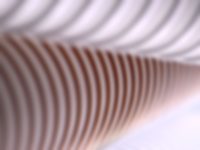Gelsenkirchen, Germany, 1 October 2014 – Experts on explosion protection from the company B·A·D Gesundheitsvorsorge und Sicherheitstechnik GmbH (professional association for occupational health and safety services) from different federal states met at the end of September at the Masterflex Group, based in Gelsenkirchen, to learn more about electrically conductive and antistatic hoses. This is because the main task of these experts from BAD is to identify possible sources of ignition in hazardous areas in businesses. The BAD experts advise companies such as large food and fodder companies as to how they can prevent static charges in production. Such preventive safety measures are necessary, for example, due to the requirements of the German Ordinance on Industrial Health and Safety (BetrSichV) for production systems in potentially explosive areas.
Guenter Grueneberg, Safety Engineer and expert in explosion protection, as well as the Technical Director of the BAD inspection office in Munich, kicked off the visitor tour: “We are here to allow visitors to handle our products and speak directly with the professionals.” In a first round of presentations, Ingo Dehne, Team Leader of the in-house sales office for the brand Masterflex, presented the company group and its industry highlights, including the world's first Master-PUR-Trivolution®. As a world first, the PU hose Master-PUR-Trivolution® combines three features in that it offers antistatic, flame resistant and microbe resistant properties in a single hose. The focus then turned to general questions regarding explosion protection: How are hoses conductive? How is the risk of ignition avoided, and when does a hose need to be replaced? Masterflex staff gave informed responses to all these questions.
Tour of the production hall and warehouse
Dehne and two engineers from the engineering department, Joachim Jacobi and Stefan Nuessen, then led visitors first into the screened-off area of the production halls where the machines rotate: To start, they showed the production of electrically conductive clip hoses, for example, made from the conductive material PTFE. The materials are ordered from certified suppliers and tested regarding their electrostatic properties as needed according to the respective standard. In addition, the Masterflex Group showed its trade visitors on site how flanges and other connecting elements are cast from the polyurethane plastic. Holger Berleth, BAD employee at the site in Bonn, praised the Master-Grip clamps: “Great solution compared with conventional hose clamps.”
Conductivity of the products tested regularly
Masterflex staff then explained the procedure for extruding antistatic PU hoses. Pellets are melted and a spring steel wire is moulded to be resistant to turning and shifting. Here, water flows in the cooling circuit, which cools the fused connection. They also shed light on the film and fabric processing in the manufacturing process of various suction and delivery hoses, while visitors could also handle and examine the products. “It's great that this hose is flexible and yet so lightweight,” said Holger Berleth, giving his assessment of the anti-static PU hose Master-PUR H-MHR A. Stefan Nuessen, engineer at Masterflex Group, added, “The conductivity is still regularly tested in the production hall and recorded”. At the end of the tour, the panel of experts marvelled at the variety of sizes and shapes of Masterflex hoses and related products in the warehouse. In the concluding discussion, attention once again turned to the technology used and forward-looking ideas. Technicians in the Masterflex Group explained for example how cables must be properly connected to the flex and connected to machines. Discussion also turned to the techniques that should be used in the future to allow the conductivity of bolted joints. “A successful morning. We have seen what goes on in production as it happens, how electrically conductive and anti-static hoses are manufactured. Our group has taken on board a lot of information that we can also share when giving advice in the production facilities on site,” concluded BAD security expert Grueneberg.





